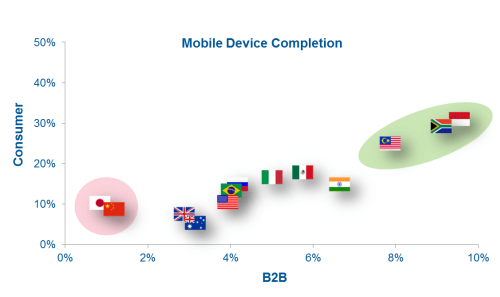Self-completion surveys on mobile devices have rapidly taken off over the last 5 years, as the spread of smart phones, cheaper data roaming and technological development has made this a feasible data collection method.

B2B International has undertaken an analysis of online surveys recently completed by business decision-makers across various regions. This shows that the markets pioneering the use of mobile devices (tablets as well as smartphones) are found in parts of South-East Asia, the Middle East, Latin America and Africa. Indonesia, South Africa and Malaysia are particularly “ahead-of-the-curve” in mobile device usage, where more B2B decision makers prefer to take part in e-surveys on their mobile devices. At the bottom of the table we find the exceptions to the South-East Asian trend, Japan and China. European markets like the UK, Germany and France are also found near the bottom with 2-3% of respondents opting for a mobile device.
Consumer research often adopts new technology before B2B research, and this is also the case for mobile self-completion surveys, where European respondents in the UK, Germany and France are about twice as likely to use a mobile device in a consumer capacity as B2B decision makers.
Interestingly, some B2B respondent groups are well-suited to mobile self-completion. B2B decision makers who have flexible working hours and who work across a range of environments show notably higher levels of mobile participation. As an example, a recent customer study carried out by B2B International amongst tradesmen saw a mobile participation rate of over 30%.
Two general trends are evident when it comes to B2B respondents opting for mobile surveys: developing markets outside Europe and North America are more likely to be mobile survey-takers, as are respondents who have mobile work patterns.


